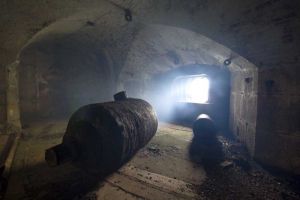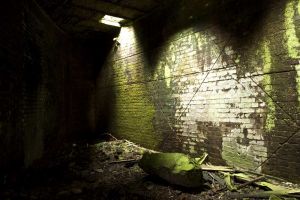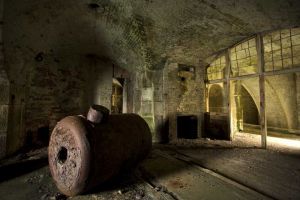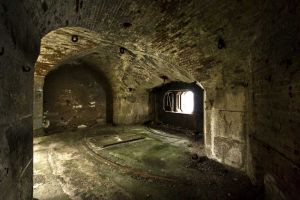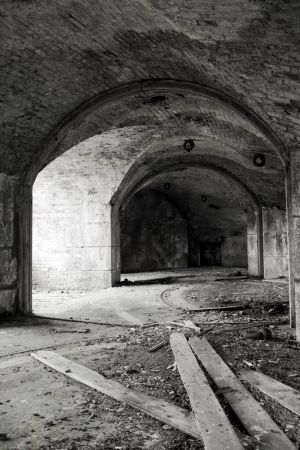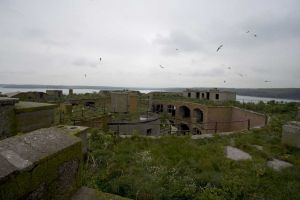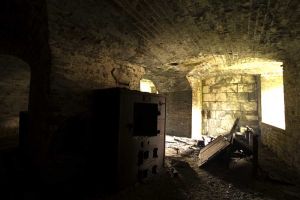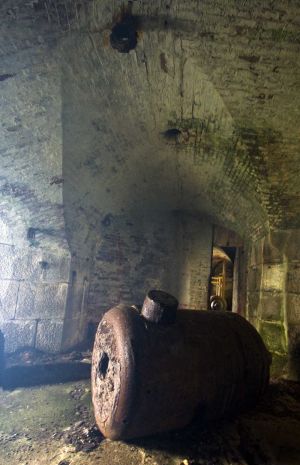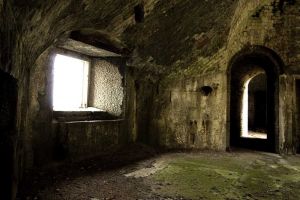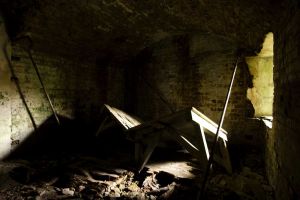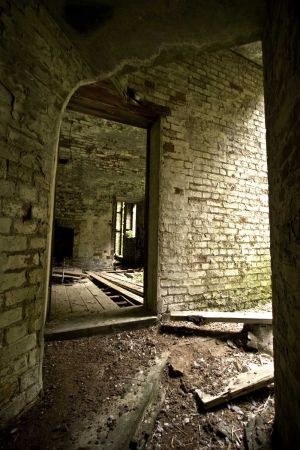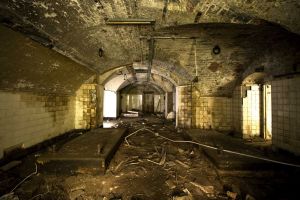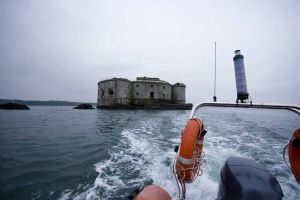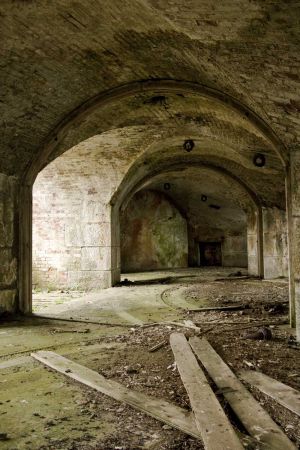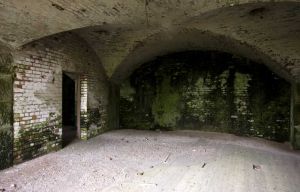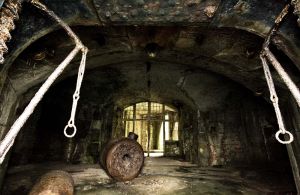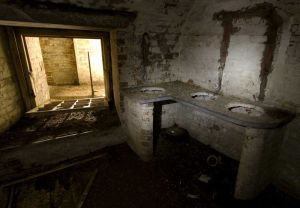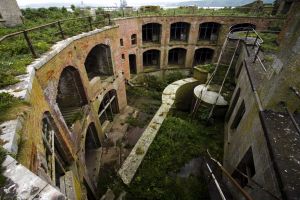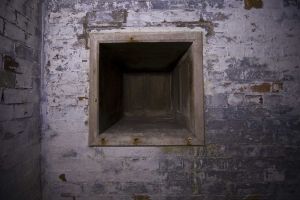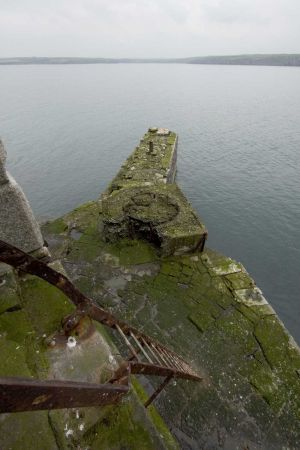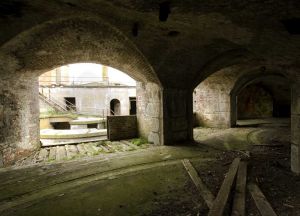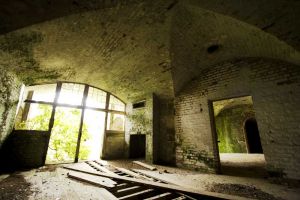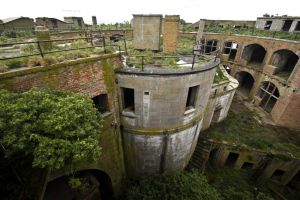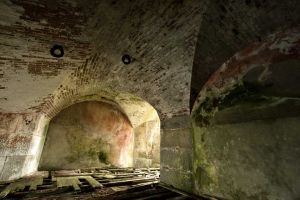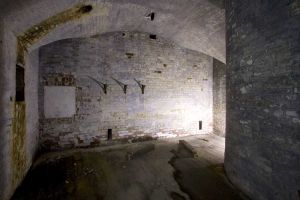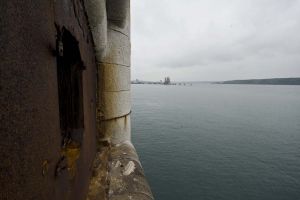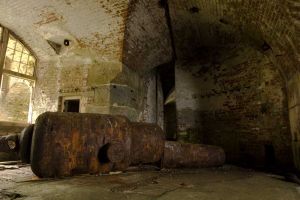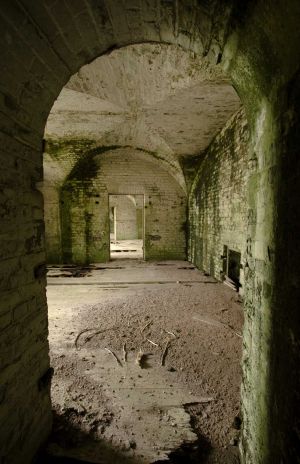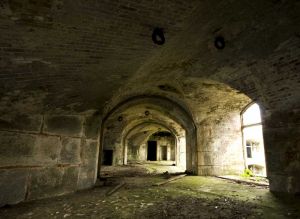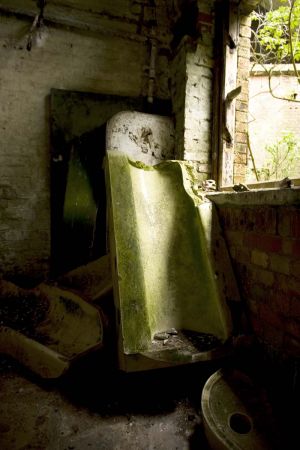Stack Rock Fort
Commenced 18 July 1859 Completed 31 December 1871
Constructed on Stack Rocks 800yds from South Hook, and 1,500 yds from Chapel Bay
Guns 23
Barrack Accommodation – 5 Officers 175 men
1929 Disarmed
Technical History
A work on Stack Rock went back to the initial proposals for the defence of the Haven made by Colonel Bryce in 1817. General Burgoyne reiterated the need for a work there and in the mid 1850s a three gun tower was built; it is not generally appreciated that this tower still remains, as it was enveloped by the casemated work that was built in the 1860s. The tower had a basement for stores and the magazine, at ground floor level was the main gun battery. Above it was the first floor with accommodation for a garrison of an officer and 30 men; above the first floor was the roof which may have had an earthen bomb proof covering that was removed at a later date. After the casemated work had been built the tower was adapted for other uses though the first floor remained as accommodation for officers.
The Fort as shown today, was originally to be a circular casemated one for 45 guns, with two tiers of casemated guns and a third tier on the roof firing through embrasures men; there was to be barrack accommodation for 250 men. This fort completely enclosed the older gun tower. The ground floor had the entrance and the casemated battery covering the Haven where 16 x 10 inch RML guns were mounted behind armoured shields. In the gorge at the rear at the entrance were three 9 inch RML guns; underneath the casemated battery were the magazines and stores. Above the gun casemates at first floor level were the casemated barracks for 5 officers and 175 men that faced inwards, again in the gorge was a casemated battery for 4 x 9 inch RMLs. There were to be, on the roof of the casemates, three turrets mounting two 25 ton guns in each, but like the Solent Forts in Portsmouth, these were never built.
With the improvement in range and accuracy of artillery by the 1880s the Fort was considered weak and the magazines insecure.; it was proposed to remove eleven of the 10 inch RMLs and all the 9 inch RMLs so that the Fort could be strengthened. By 1895 onlt 5 x 10 inch RMLs remained in the casemated battery although the 9 inch RMLs remained in the gorge. Also by this date, the Fort had acquired two 6pdr QF guns to cover a nearby minefield. In the basement, most of the old magazines were filled with concrete and those that were not adapted for other uses. A number of the armoured shields were removed from unused casemates and sent to the casemated battery at Hubberstone Fort. Three 10 inch RML barrels remain on the fort but are partially dismantled.
In 1902 positions for 4, 12pdr QF guns in two groups were built on the roof of the casemates with positions for four maxim guns. In the meantime, all the 9 inch RMLs had been withdrawn and two of the 10 inch RMLs, these latter ones were replaced by two searchlights. The remaining three 10 inch guns were retained as ‘run past’ guns until 1907/8.
During WW1 two of the 12pdr QF were withdrawn; by 1929 the searchlights and the remaining two 12pdr QF were removed and the Fort was sold in 1932 for £60. In many ways the Fort is the most interesting of the Haven’s defences though sadly the most inaccessible. It is in private ownership and I am very grateful to have been permitted to take these photographs.
STACK ROCK FORT UFO PHENOMENA
For UFO enthusiasts, I am certain you will be familiar with the Bermuda Triangle, but there is such a thing as the West Wales Triangle with equally baffling accounts.
1977 locals were subjected to regular UFO activity and one family in particular were victims of weird events. Their cattle was reported to have teleported, televisions and copper wiring would explode in their home, lights and craft would chase their car to and from their farm overlooking the sea and Fort, they even had a visit from the ‘men in black’.
These prolonged events were supported by independent witnesses, some of whom were local police.
Stack Rock Fort was seen to be the location where many of these strange craft and light activity would emanate and it was believed by many that extra terrestrial beings had used the site as a base. You can read the full account in a book entitled ‘The Uninvited’.
Bombardier John James (Jack) Morris One time stationed on Stack Rock Fort
Early Years
Born in Fishguard, Pembrokeshire in 1896, Jack Morris was the first son of Benjamin and Martha Morris. Little is known at this time of his early life but the family lived in and around Fishguard with his father being employed on the harbour wall construction project. As a young man he elected to join the Territorial Force and became a gunner in the Royal Garrison Artillery (RGA). At the time, the RGA were deployed as part of a home defence force and mainly found themselves manning coastal batteries. In 1914, at the outbreak of war, Jack was stationed on Stack Rock fort at the entrance to Pembroke Dock.
The Somme
Exact events remain unclear but evidence supplied by surviving documentation suggests that, once the Territorial Force was authorised for service overseas, Jack was posted to 16th Heavy Battery, RGA. This had formed in support of the 16th Division in early 1915 and was initially moved to Winchester before embarking for Le Havre. The Division arrived in France on 15 March 1915 and were initially billeted at Harfleur before moving up to the Somme area shortly afterwards. On arrival, the unit was deployed close to the village of Beausart behind the front line village of Auchonvillers. Jack’s notebooks give the gun position as ‘left of Beausart railway station’ and many of the local church spires are noted in terms of both bearing and range. The battery is believed to have remained in support throughout the Somme battles of 1916 and Jack was definitely in the area for that time as he bought several presents for his mother and sisters in the village of Maillet Mallet.
Ypres
The battery is believed to have moved to the Ypres area in early 1917 and Jack was by now a Bombardier and a signaller. His notebooks also reveal two longstanding friends, gunner Hill, who came from Lancashire and gunner Potter who came from Cornwall. Little is known about their exact movements during the Passchendaele battles until all three were killed together in the early hours of September 11 1917. The bodies were recovered and they lie buried together in Bard Cottage Cemetery which is situated on the other side of the road and a little further along in the direction of Boesinghe from Essex Farm. www.roll-of-honour.org
EAGLE
From a transcription of an article from the Haverfordwest & Milford Haven Telegraph, Wednesday 18th December 1912, in the Les Jones Archive.
APPALLING DISASTER IN MILFORD HARBOUR
STEAM TRAWLER CUTS STEAM LINER IN HALF
FIVE MEN PERISH IN SIGHT OF HOME
Town and port grief stricken
Not since the time, five years ago, when the steam trawler “Devon” with her crew of nine men left Milford Docks for the fishing grounds and never returned, has such a calamity occurred to a local vessel as that of last Wednesday night. The “Devon’s” fate was never known beyond the conclusion that might be drawn from the picking up of her lifebouys, and even this was after a time of terrible suspense. This disaster is the work of a moment and is full of sadness and pathos. Picture a little steam line fishing vessel after a week’s fishing, having withstood successfully the mountainous seas, returning, skipper and men well contented with the result of their labours, and looking forward to marketing her cargo of conger, cod, roker, etc., on the morrow. She safely makes the familiar Haven and enters Dale Roads, where the owner resides. He responds to the vessel’s signal, puts off from shore and is taken aboard. She steams up channel in the darkness, the crew probably thinking of home, of wives, children and sweethearts. A few short miles and the Dock will be reached, but midway between Thorne Island and Stack Rock Fort, without one word of warning, the craft is struck by an unseen vessel, almost within sight of the home lights. That is the story of the “Eagle”. She went down with five of her crew. She was owned by Mr James Roch of Dale, and had been working from Milford for rather less than two years. She carried a crew of eight men.
The other vessel was the steam trawler “Cyelse”, owned by Councillor David Pettit, and is the latest addition to his fleet. She had left Milford Docks on the morning’s tide, but some repairs not being completed, the ship was anchored outside practically all day. Her skipper is E. Gibbs, and he says that shortly after six o’clock on Wednesday evening he was steaming down the Haven when he saw a bright light on his starboard bow, and then suddenly a red light cross his bow. He immediately rang his engines to full astern, but it was too late. “Good God,” the skipper exclaimed, “we have cut her in two!” The “Cyelse” had crashed into the “Eagle” by her boilers and the liner sank like a stone. Mr Roch, the owner, with his knife cut the lashings of the “Eagle’s” small boat, but the anchor of the “Cyelse” was within reach and he made a grab and by means of a wire rope succeeded in getting aboard the trawler. Archie Sturley, the cook, did the same, but the skipper, George Sturley, although hanging on to the anchor, had a trying experience before he was hauled aboard. He had almost given up hope and could not have held out much longer. Meanwhile Mate William Blockwell of the “Cyelse” had lowered her small boat and went in search of the “Eagle’s” crew in which work he was joined by his son of the same name and after a time they succeeded in picking up George Hicks, who was in an exhausted state.
The steam trawler “Fishergate” was lying at anchor not far from the scene of the disaster, and he promptly steamed to the spot. They found that the Blockwells’ and Hicks were now in distress as their boat was sinking and the three were taken aboard the “Fishergate”. It was very dark, with a thick drizzle falling. The two trawlers steamed round and round in search of the missing men, but not a sound could be heard and the trawlers afterwards returned to Milford Docks, which they entered just after eight o’clock. Skipper McLean and Chief Engineer Narbett of the steam trawler “Fishergate” went at once to inform their owner, Mr G.H.D. Birt, who was at the Masonic Hall at the Territorial prize distribution. Mr Birt hurried down to the Dock. In an interview the skipper said his ship was at anchor down the Haven, about two hundred yards away from the spot where the catastrophe occurred, halfway between Thorne Island and Stack Rock. A thick rain was falling and it was blowing hard. He heard the crash and could see the collision. They had steam up and he promptly proceeded to render any assistance he could. The boat was lowered and they searched the waters round about for a considerable time, and picked up Hicks and the Blockwells, whose boat had been swamped, and after a time returned to port. When seen in Dock the survivors were all suffering from exhaustion, and the scene at the Dock side was heartrending. The men’s concern was for their missing shipmates. Hopes were held out that the men might have managed to swim ashore and get to safety on the Chapel Bay side of the Haven, but when next morning there was no news, their fate was certain.
NAMES OF THE PERISHED.
The names of the men who perished are:
William Pearson. Mate,(26), married, five children, living at Pill, a native of Yarmouth or Lowestoft.
George Spindler. Boatswain. (25), married, one child,living in Hakin, a native of Lowestoft.
William Carpenter. Deckhand. (2l),Single. Living in Hakin.
Bert Dainton. Chief Engineer. (35), married, two children, living in Priory Road, a native of Bristol.
Henry Mawby. Second Engineer. (32), single, living in Hakin.
TO BE MARRIED THIS CHRISTMAS.
The men were all well-known and highly respected. Carpenter was a particularly well set up young fellow, standing over 6 feet, and was to be married to Miss Winnie Mathias this Christmas.
THE RESCUED.
The names of the rescued men are:
James Roch. Owner,Dale.
George Sturley. Skipper, a native of Dale.
Archie Sturley. Cook, a native of Dale.
George Hicks. Deckhand,Living at Haven’s Head,Hakin,a native of Lowestoft.
Reports as to the cause of the calamity are conflicting and it is difficult to get at the the circumstances. These will in all probability form the subject of an official enquiry, or, should any of the bodies be recovered, something may be gleaned in evidence at the inquest. The Skipper and Mate of the “Cyelse” are very emphatic that a good look out was kept on the trawler, and that no light could be observed until the “Eagle” was right under their bows. They say they did all in their power to avert a collision. We join in the sincere sympathy which is universally expressed with the bereaved families.
As an indication of the sorrow of the town and port, flags were flown half-mast from all the vessels in Dock and offices, and also on various buildings throughout the town which is indeed grief-stricken.
________________________
From the Haverfordwest & Milford Haven Telegraph, Wednesday 25th December 1912:
THE EAGLE DISASTER
A sharp look-out has been kept in the harbour for several days, with a view to the recovery of the bodies of the fishermen who met their death in the collision on the night of December 11th last. The scene of the disaster has been watched and signals shown for the safety of shipping, and on Saturday the Trinity steamer “Viking” carried out blasting operations and the wrecked liner was successfully blown up. If any of the men were entrapped in the vessel it was expected that the bodies would have been washed ashore with the wreckage, but up till last night nothing had been seen. On Saturday night the Milford Haven Male Voice Party, always ready to give their services in the cause of charity, rendered choruses in various parts of the town in aid of the fund for the relief of the distressed families of the men who lost their lives in the “Eagle”. We sincerely trust that a hearty response will be forthcoming for this worthy object.
~~~~~~~~~~~~~~~~~~~~~~
From the Haverfordwest and Milford Haven Telegraph of Wednesday 21st February 1913:
[ The concluding paragraph of a lengthy report on the inquiry into the loss of the EAGLE: ]
THE JUDGEMENT
The judgement was announced at noon on Monday.
The Court found:
The loss of the steamship Eagle and the consequent loss of life were caused by the collision with the steamship Cyelse, which collision was brought about by the defective look out kept on on the Cyelse, and by that vessel failing to keep clear of the Eagle as she should have done. The efforts to save life made by the men of the Cyelse after the collision were os an unsatisfactory character, largely due to the fault of the second hand.
For the above- mentioned defaults the Court suspends the certificate of Edward Gibbs, the skipper of the Cyelse, for nine months, and that of the second hand, William Blockwell, for three months.
The court finds George Ernest Sturley, skipper of the Eagle, not in default for the collision, but censures him for not exhibiting his masthead lights in accordance with the regulation.
